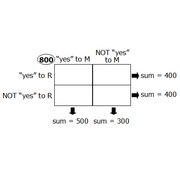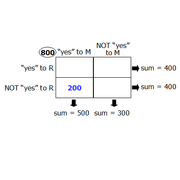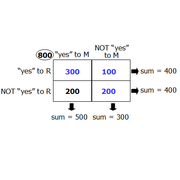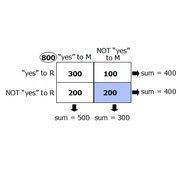I spent about 4 minutes on this and gave up, the official explanation was tough to understand as well. Anybody has a way to explain it in another way?
Yes ~ No ~ Unsure
==================================
Subject M ~ 500 ~ 200 ~ 100
Subject R ~ 400 ~ 100 ~ 300
A total of 800 students were asked whether they found two subjects M and R, interesting. Each answer was either "yes"or "no" or "unsure", and the numbers of students who gave the answers are listed above in the table above. If 200 students answered "yes" only for subject M , how many of the students did NOT answer "yes for each answer?
A. 100
B. 200
C. 300
D. 400
E. 500
Thank you.
Please help explain this probability question
This topic has expert replies
- utkalnayak
- Senior | Next Rank: 100 Posts
- Posts: 53
- Joined: Thu Dec 25, 2014 2:23 pm
- Thanked: 1 times
GMAT/MBA Expert
- Brent@GMATPrepNow
- GMAT Instructor
- Posts: 16207
- Joined: Mon Dec 08, 2008 6:26 pm
- Location: Vancouver, BC
- Thanked: 5254 times
- Followed by:1268 members
- GMAT Score:770
One approach is to use the Double Matrix Method. This technique can be used for most questions featuring a population in which each member has two characteristics associated with it (aka overlapping sets questions).----------------YES---------NO----UNSURE
Subject M----500--------200-----100
Subject R----400--------100-----300
A total of 800 students were asked whether they found two subjects, M and R, interesting. Each answer was either "yes" or "no" or "unsure", and the numbers of students who gave these answers are listed in the table above. If 200 students answered "yes" only for subject M, how many of the students did not answer "yes" for either subject?
A. 100
B. 200
C. 300
D. 400
E. 500
Here, we have a population of students, and the two characteristics are:
- Said "yes" to liking subject M or didn't say "yes" to liking subject M
- Said "yes" to liking subject R or didn't say "yes" to liking subject R
IMPORTANT: Notice that I just lumped the "unsure" respondents in with those who answered "no." It's okay to do this since the question is only interested in those who did not answer "yes"
So, we can CONDENSE our table to get:
Subject M: 500 answered "yes," and 300 did NOT answer "yes"
Subject R: 400 answered "yes," and 400 did NOT answer "yes"
We can now set up our diagram as follows:

The question tells us 200 students answered "yes" only for subject M
So, we know that 200 students can be placed in the bottom-left box:

From here, we can find the other values in the empty boxes:

The question asks: How many of the students did not answer "yes" for either subject?
The bottom-right box represents those students:

So, the correct answer is B
------------------------
NOTE: This question type is VERY COMMON on the GMAT, so be sure to master the technique.
To learn more about the Double Matrix Method, watch our free video: https://www.gmatprepnow.com/module/gmat- ... ems?id=919
Once you're familiar with this technique, you can attempt these additional practice questions:
Easy Problem Solving questions
- https://www.beatthegmat.com/the-aam-aadm ... 72242.html
- https://www.beatthegmat.com/finance-majo ... 67425.html
Medium Problem Solving questions
- https://www.beatthegmat.com/probability- ... 73360.html
- https://www.beatthegmat.com/posted-speed ... 72374.html
- https://www.beatthegmat.com/motel-t271938.html
- https://www.beatthegmat.com/of-the-appli ... 70255.html
- https://www.beatthegmat.com/opening-nigh ... 64869.html
- https://www.beatthegmat.com/ds-french-ja ... 22297.html
Difficult Problem Solving questions
- https://www.beatthegmat.com/ratio-problem-t268339.html
- https://www.beatthegmat.com/overlapping- ... 65223.html
- https://www.beatthegmat.com/fractions-t264254.html
- https://www.beatthegmat.com/overlapping- ... 64092.html
- https://www.beatthegmat.com/mba/2011/05/ ... question-2
Easy Data Sufficiency questions
- https://www.beatthegmat.com/for-what-per ... 70596.html
- https://www.beatthegmat.com/ds-quest-t187706.html
Medium Data Sufficiency questions
- https://www.beatthegmat.com/sets-matrix-ds-t271914.html
- https://www.beatthegmat.com/each-of-peop ... 71375.html
- https://www.beatthegmat.com/a-manufacturer-t270331.html
- https://www.beatthegmat.com/in-costume-f ... 69355.html
- https://www.beatthegmat.com/mba/2011/05/ ... question-1
Difficult Data Sufficiency questions
- https://www.beatthegmat.com/double-set-m ... 71423.html
- https://www.beatthegmat.com/sets-t269449.html
- https://www.beatthegmat.com/mba/2011/05/ ... question-3
Cheers,
Brent
- MartyMurray
- Legendary Member
- Posts: 2131
- Joined: Mon Feb 03, 2014 9:26 am
- Location: https://martymurraycoaching.com/
- Thanked: 955 times
- Followed by:140 members
- GMAT Score:800
Well first of all, we already know how many did not answer "yes" for each subject. What I believe the question to be asking is how many did not answer "yes" for either subject.utkalnayak wrote:I spent about 4 minutes on this and gave up, the official explanation was tough to understand as well. Anybody has a way to explain it in another way?
Yes ~ No ~ Unsure
==================================
Subject M ~ 500 ~ 200 ~ 100
Subject R ~ 400 ~ 100 ~ 300
A total of 800 students were asked whether they found two subjects M and R, interesting. Each answer was either "yes"or "no" or "unsure", and the numbers of students who gave the answers are listed above in the table above. If 200 students answered "yes" only for subject M , how many of the students did NOT answer "yes for each answer?
A. 100
B. 200
C. 300
D. 400
E. 500
Thank you.
We know that of the 500 who answered "yes" for M, 200 answered "yes" only for M. If I am reading it correctly, that leaves 300 who answered "yes" for both M and R. 500 - 200 = 300
So if 300 answered "yes" for both, then of the 400 who answered "yes" for R, 300 answered "yes" for both and 100 answered "yes" just for R. 400 - 300 = 100
So we have the following.
200 answered "yes" for only M.
300 answered "yes" for both.
100 answered "yes" for only R.
Total who answered "yes" is 600.
Total students - Total who answered "yes" = Total who did not answer "yes" for either one
800 - 600 = 200
Choose B.
Marty Murray
Perfect Scoring Tutor With Over a Decade of Experience
MartyMurrayCoaching.com
Contact me at [email protected] for a free consultation.
Perfect Scoring Tutor With Over a Decade of Experience
MartyMurrayCoaching.com
Contact me at [email protected] for a free consultation.
- GMATGuruNY
- GMAT Instructor
- Posts: 15539
- Joined: Tue May 25, 2010 12:04 pm
- Location: New York, NY
- Thanked: 13060 times
- Followed by:1906 members
- GMAT Score:790
An alternate approach is to use a Venn diagram to represent all of the YES voters:----------------YES---------NO----UNSURE
Subject M--------500--------200-----100
Subject R--------400--------100-----300
A total of 800 students were asked whether they found two subjects, M and R, interesting. Each answer was either "yes" or "no" or "unsure", and the numbers of students who gave these answers are listed in the table above. If 200 students answered "yes" only for subject M, how many of the students did not answer "yes" for either subject?
A. 100
B. 200
C. 300
D. 400
E. 500

The TOTAL who voted YES for M = 500.
The number who voted YES for ONLY M = 200.
Thus, the number who voted YES for BOTH M AND R = 300.
Since the TOTAL number who voted YES for R=400, and 300 of these people voted YES for BOTH M AND R, the number who voted YES for ONLY R = 400-300 = 100.
Adding the values in the Venn diagram, we get:
Total number of YES voters = 200+300+100 = 600.
Since the total number of voters = 800, and the total number of YES voters = 600, the number who did NOT vote YES = 800-600 = 200.
The correct answer is B.
Private tutor exclusively for the GMAT and GRE, with over 20 years of experience.
Followed here and elsewhere by over 1900 test-takers.
I have worked with students based in the US, Australia, Taiwan, China, Tajikistan, Kuwait, Saudi Arabia -- a long list of countries.
My students have been admitted to HBS, CBS, Tuck, Yale, Stern, Fuqua -- a long list of top programs.
As a tutor, I don't simply teach you how I would approach problems.
I unlock the best way for YOU to solve problems.
For more information, please email me (Mitch Hunt) at [email protected].
Student Review #1
Student Review #2
Student Review #3
Followed here and elsewhere by over 1900 test-takers.
I have worked with students based in the US, Australia, Taiwan, China, Tajikistan, Kuwait, Saudi Arabia -- a long list of countries.
My students have been admitted to HBS, CBS, Tuck, Yale, Stern, Fuqua -- a long list of top programs.
As a tutor, I don't simply teach you how I would approach problems.
I unlock the best way for YOU to solve problems.
For more information, please email me (Mitch Hunt) at [email protected].
Student Review #1
Student Review #2
Student Review #3
-
gmatdriller
- Master | Next Rank: 500 Posts
- Posts: 418
- Joined: Sun Jul 04, 2010 12:48 pm
- Thanked: 6 times
- Followed by:3 members
The "YES", "NO", "UNSURE" parts are treated as 3 different matrices or sets.
GMAT deliberately included all the stuffs to cause confusion.
GMAT deliberately included all the stuffs to cause confusion.
-
regor60
- Master | Next Rank: 500 Posts
- Posts: 415
- Joined: Thu Oct 15, 2009 11:52 am
- Thanked: 27 times
Problems states that 200 answered "yes" only to M.
That means they answered "unsure" or "no" to R.
Subject R counts 400 Unsure/No, 200 of which must therefore be "yesses" for M
Therefore, the remainder of 200 are those who answered no to R and M
That means they answered "unsure" or "no" to R.
Subject R counts 400 Unsure/No, 200 of which must therefore be "yesses" for M
Therefore, the remainder of 200 are those who answered no to R and M




















